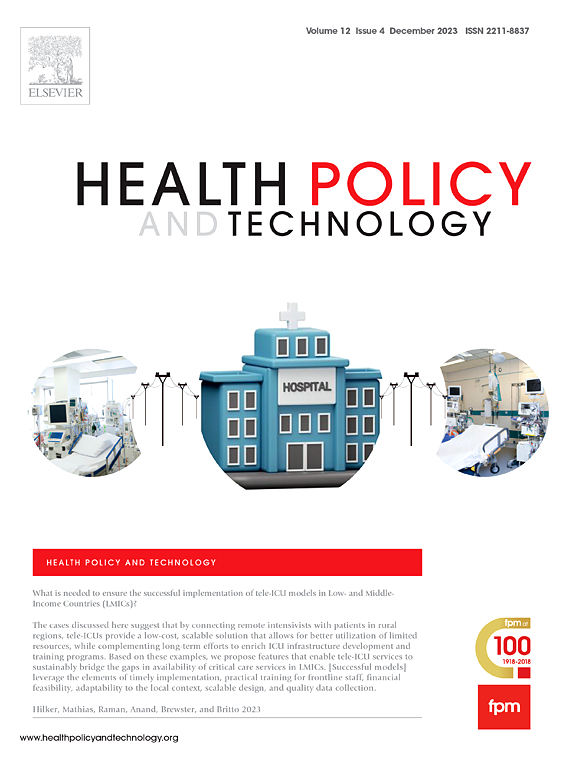Dynamic decision system for ENT surgery waiting list prioritization using M-Score and TOPSIS methodology
IF 3.7
3区 医学
Q1 HEALTH POLICY & SERVICES
引用次数: 0
Abstract
Objective: This study aims to develop and evaluate a dynamic prioritization system to improve surgical waiting list management for otorhinolaryngology (ENT) patients in a high-complexity public hospital in Chile. The proposed model aims to reduce waiting times and improve equity and clinical outcomes by dynamically incorporating changes in patient condition. Methods: We implemented a dynamic scoring system (M-Score), updated weekly using multidimensional biopsychosocial criteria, and integrated it with the Technique for Order Preference by Similarity to Ideal Solution (TOPSIS) to prioritize patients. The evaluation was carried out using Monte Carlo simulations over a 52-week horizon, simulating patient inflows and outflows via a balanced flow model. The stability and performance of the proposed model were compared with a static model and a traditional first-come, first-served (FCFS) protocol. Results: The proposed approach reduced the average waiting time from 130 to 91 days compared to the static model (a 30 % relative and absolute decrease of 39 days) and from 157 to 91 days compared to FCFS (a 42 % relative and absolute reduction of 66 days). The greatest improvements were observed among high-risk patients, whose prioritization was adapted in real time to worsening clinical conditions. Conclusions: Our adaptive prioritization model demonstrates significant improvements in waiting time management, particularly for clinically vulnerable patients. Although the findings support its feasibility, further prospective validation is necessary before clinical implementation. Future research should focus on real-time integration with electronic medical records, scalability between specialties, and evaluation of impacts on patient satisfaction and health outcomes. Lay Summary: ENT patients in public hospitals often face long waiting times that increase health risks. This study introduces a weekly update to the prioritization model using social and health factors of the patient. The system reduced average waiting times by up to 66 days in simulation. High-risk patients were prioritized as their conditions worsened. This approach offers a promising data-driven strategy for improving waitlist management and resource allocation in public healthcare.
基于M-Score和TOPSIS方法的耳鼻喉外科候诊名单优先排序动态决策系统
目的:本研究旨在开发和评估动态优先排序系统,以改善智利一家高复杂性公立医院耳鼻喉科(ENT)患者的手术等待名单管理。提出的模型旨在通过动态结合患者病情的变化来减少等待时间,提高公平性和临床结果。方法:我们实施了一个动态评分系统(M-Score),每周更新一次,使用多维生物心理社会标准,并将其与理想解决方案相似性排序偏好技术(TOPSIS)相结合,对患者进行优先排序。评估使用蒙特卡罗模拟进行,为期52周,通过平衡流动模型模拟患者流入和流出。将该模型的稳定性和性能与静态模型和传统的先到先服务(FCFS)协议进行了比较。结果:与静态模型相比,该方法将平均等待时间从130天减少到91天(相对和绝对减少39天,减少30%),与FCFS相比,该方法将平均等待时间从157天减少到91天(相对和绝对减少66天,减少42%)。在高危患者中观察到最大的改善,他们的优先级实时适应恶化的临床状况。结论:我们的适应性优先排序模型显示了等待时间管理的显著改善,特别是对临床弱势患者。尽管研究结果支持其可行性,但在临床应用之前需要进一步的前瞻性验证。未来的研究应集中在与电子病历的实时集成、专科之间的可扩展性以及对患者满意度和健康结果影响的评估上。概要:公立医院的耳鼻喉科病人经常面临长时间的等待,这增加了健康风险。这项研究引入了每周更新的优先级模型,使用患者的社会和健康因素。在模拟中,该系统将平均等待时间缩短了66天。随着病情恶化,高危患者被优先考虑。这种方法为改善公共医疗保健的候补名单管理和资源分配提供了一种有前途的数据驱动策略。
本文章由计算机程序翻译,如有差异,请以英文原文为准。
求助全文
约1分钟内获得全文
求助全文
来源期刊

Health Policy and Technology
Medicine-Health Policy
CiteScore
9.20
自引率
3.30%
发文量
78
审稿时长
88 days
期刊介绍:
Health Policy and Technology (HPT), is the official journal of the Fellowship of Postgraduate Medicine (FPM), a cross-disciplinary journal, which focuses on past, present and future health policy and the role of technology in clinical and non-clinical national and international health environments.
HPT provides a further excellent way for the FPM to continue to make important national and international contributions to development of policy and practice within medicine and related disciplines. The aim of HPT is to publish relevant, timely and accessible articles and commentaries to support policy-makers, health professionals, health technology providers, patient groups and academia interested in health policy and technology.
Topics covered by HPT will include:
- Health technology, including drug discovery, diagnostics, medicines, devices, therapeutic delivery and eHealth systems
- Cross-national comparisons on health policy using evidence-based approaches
- National studies on health policy to determine the outcomes of technology-driven initiatives
- Cross-border eHealth including health tourism
- The digital divide in mobility, access and affordability of healthcare
- Health technology assessment (HTA) methods and tools for evaluating the effectiveness of clinical and non-clinical health technologies
- Health and eHealth indicators and benchmarks (measure/metrics) for understanding the adoption and diffusion of health technologies
- Health and eHealth models and frameworks to support policy-makers and other stakeholders in decision-making
- Stakeholder engagement with health technologies (clinical and patient/citizen buy-in)
- Regulation and health economics
 求助内容:
求助内容: 应助结果提醒方式:
应助结果提醒方式:


